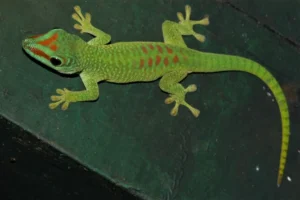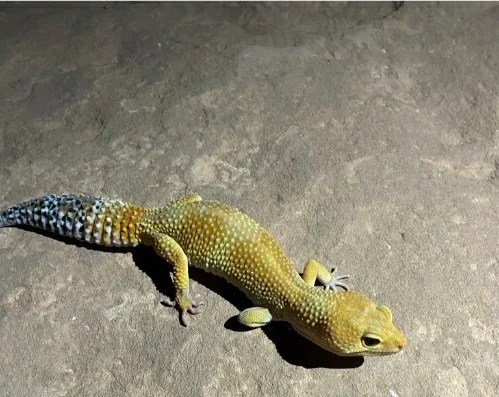It’s late at night, and your gecko is usually calm, climbing along a branch or resting quietly on a rock. Then, suddenly, it bursts into a sprint across the tank.
Its little legs move faster than you thought possible, tail whipping back and forth, eyes wide and alert. You blink and wonder, do geckos actually get the zoomies?
Yes, geckos can get zoomies, although not exactly like dogs or cats. That sudden burst of energy happens when geckos feel excited, stressed, or just need to burn off energy. It’s normal and usually nothing to worry about. Basically, it’s their way of moving fast when the moment hits, whether they’re chasing something, exploring, or reacting to their environment.
What Gecko Zoomies Look Like
Gecko zoomies aren’t constant. They happen suddenly and only last a short time. You might notice:
-
Rapid running across the enclosure
-
Tail wagging or flicking while sprinting
-
Quick stops and turns, as if testing every corner
-
Sudden jumps or climbs onto branches or walls
Unlike dogs, geckos don’t get zoomies to play with you. These bursts are usually about instinct, exploration, or reacting to their surroundings.

Leopard geckos, crested geckos, and day geckos all show zoomies differently. Some run straight for a few seconds, others zigzag or climb wildly before settling down.
Watching closely, you can start to see patterns tied to time of day, environment, and even recent feeding.
Why Geckos Get Zoomies
Geckos can suddenly bolt for a few main reasons.
1. Exploration and curiosity
Geckos are naturally curious. If you’ve just rearranged their enclosure, added a new branch, or changed the substrate, they might sprint from one spot to another.
These bursts are usually a mix of excitement and nervousness. The gecko is mapping its space, checking for safety, all in a flash of movement.
2. Hunting and feeding instincts
After introducing a meal, geckos sometimes get zoomies while stalking or chasing prey. That sudden sprint is part of hunting behavior:
-
Leopard geckos may chase crickets with bursts of speed.
-
Crested geckos might dash to a dangling fruit or small insect.
-
Day geckos can climb and leap quickly before settling down.
Even after catching prey, geckos might continue sprinting for a few seconds. It’s part adrenaline, part instinct, and part excitement.
3. Energy release
Geckos store energy in their bodies. Sometimes they just need a quick outlet. Young geckos especially build up extra energy after rest or inactivity.
A short sprint stretches muscles, moves blood, and keeps limbs flexible. It’s like a tiny workout.
4. Stress or alarm
Zoomies can also happen if a gecko is startled or feels threatened. Sudden movements outside the tank, shadows, or unfamiliar presence can trigger an escape sprint.
Stress zoomies usually look like:
-
Rapid zigzagging
-
Hiding immediately afterward
-
Tail wagging in a defensive posture
It’s important to tell the difference between normal bursts and stress-driven sprints.
Repeated stress zoomies may mean the gecko is uncomfortable in its environment.
5. Nighttime activity
Most geckos are crepuscular or nocturnal, meaning they are more active at dusk or night. Zoomies often happen just as the lights dim, even if nothing in the tank has changed.
It’s their internal clock telling them it’s time to explore, hunt, or move around.
Differences Between Gecko Species
Zoomies aren’t the same for every species:
-
Leopard geckos: Short bursts, mostly close to the ground. They run and hide rather than climb.
-
Crested geckos: Dashes can be vertical, climbing and leaping across branches.
-
Day geckos: Agile climbers and jumpers, so zoomies may include jumps and quick changes in direction.
-
Tokay geckos: Strong, fast, and territorial, their sprints usually respond to perceived threats rather than playful energy.

Observing your gecko over time helps you understand what kind of zoomies are normal for its species.
How to Recognize Normal Zoomies
Normal gecko zoomies usually:
-
Last a few seconds to a minute
-
Happen suddenly but not all the time
-
End with the gecko settling down, hiding, or resuming normal activity
-
Don’t show signs of pain or illness
If you see constant frantic running, head bobbing, or repeated wall collisions, that could signal stress, illness, or environmental issues.
Safety Tips During Zoomies
Even though zoomies are natural, you want the enclosure to be safe:
-
Avoid sharp edges: Smooth out rocks, logs, or decorations to prevent injuries.
-
Secure climbing spots: Make sure branches and hides are stable.
-
Avoid overcrowding: Too many geckos in a small space can trigger stress zoomies.
-
Provide hiding spots: Geckos often sprint to escape perceived threats; shelters reduce stress.
A safe environment lets your gecko zoom around naturally without getting hurt.
When Zoomies Could Signal Stress
While most zoomies are normal, repeated frantic bursts may show a problem. Look for:
-
Constant running back and forth
-
Tail wagging with defensive posture
-
Trying to escape the enclosure repeatedly
-
Refusing to eat or hiding too much
Check the environment for causes:
-
Temperature and humidity
-
Proper hides and climbing options
-
Tank size and layout
-
Noise or vibrations
Fixing environmental stressors usually reduces unwanted zoomies.
Conclusion
So, do geckos get zoomies? Yes, and it’s completely normal. Whether it’s a burst of energy to explore, hunt, or react to a change in the environment, zoomies are part of how geckos live, move, and react.
Watching your gecko sprint can be entertaining and a little surprising. It shows you a healthy, active reptile. As long as the behavior is short, safe, and not paired with signs of stress or illness, you can enjoy the show.
Gecko zoomies remind us that even small, quiet creatures have ways to express energy, curiosity, and instinct. They may be silent, but those tiny sprints say a lot about how they interact with the world.
Hi, my name is Ezra Mushala, i have been interested animals all my life. I am the main author and editor here at snakeinformer.com.

